
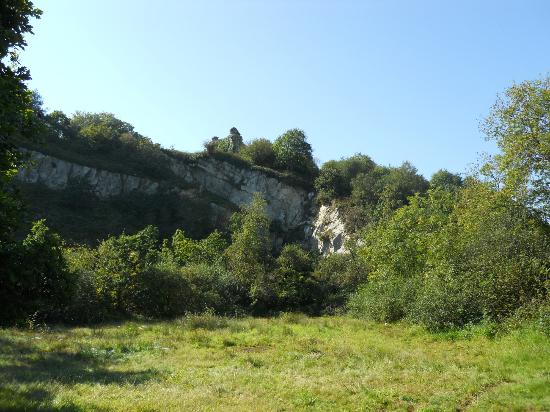
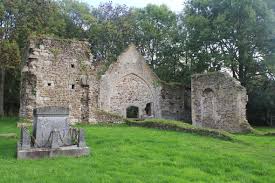
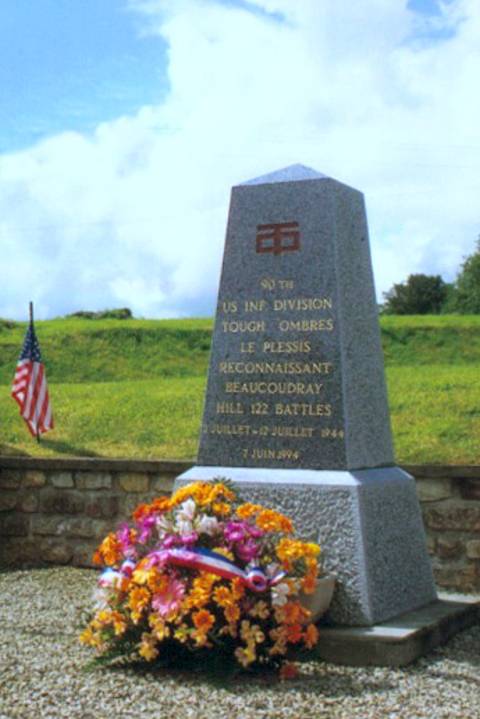

The Jim Flowers Story
The hill is just to the east of La Haye du Puits and was one of the first battles in the Normandy breakout. Mont Castre is a small hill just over 300 ft above sea level. It was used by early man and was a fort in Roman times. In 56bc Caesar’s army under Quintus Titurius Sabinus used this as a camp for his army of 18,000 men during his battle with the Gauls. In 1944 the Germans had dug themselves in on Hitler’s orders to stop the American advance to the south. They called it the Mahlmann Line and it was defended by an elite Regiment the 15th Regiment of the 5th Parachute Division. Cherbourg had already fallen to the Americans and they now turned their attention to a southern breakthrough. On July 3rd at 05:30 the attack began with three Infantry Divisions, from east to west they were 79th and 82nd Airborne, plus the 90th starting in a line from Port Bail to Pretot. The main assault on the hill was made by 1 battalion of the 358th and two battalions of the 359th, both from the 90th Division. By the evening of the 5th they had fought their way to the foot of Hill 122 but it took a further four days to drive the Germans from the hill. It took until July 12th to reach Plessis-Lastelle at enormous cost to both armies, over 5,000 casualties in the 90th Division. To put the battle into perspective, the 90th Division had 26% of all the causalities suffered by the Allied Army’s in all theatres of the war during that week. The 3rd Battalion of the 358th Regiment which started with 19 officers and 582 men lost 11 officers and 343 men in a single days fighting. It took a further five days fighting to reach the town of Periers just eight miles away. Today the site of Hill 122 is a nature reserve and also of interest is the ruined chateau and church, together with traces of the Roman camp. On the other side of the hill at Plessis-Lastelle is a ruined castle. Built by William the Conquer in 1047, this castle suffered damage during the battle for the hill, and has now been turned into a site of pilgrimage and has the journey of the Stations of the Cross leading to the summit.
There are three monuments around the hill firstly at La Gauterie there is a marker to the 82nd and 90th. A little further round the hill at the water pumping station there is one to the 712th Tank Regiment, and finally at Plessis-Lastelle there is a monument to the 90th. Jim Flowers a tank commander in the 712th tried to relieve the third Battalion of the 358th on July 10th, who were surrounded by a force of German Paratroopers. With a force of four Sherman’s he traversed the forest, not really a suitable terrain for tanks. One tank became bogged down in a marsh to the right of the monument, but continued two give covering fire. The other three continued but were soon knocked out by a 88 mm gun hidden in the hedgerow. The surviving crews defended their position whilst their tanks burned around them. Jim Flowers had been hit in the leg and he used his belt as a tourniquet, as well as the injury to his leg his hands were also badly burnt. Some of the crew managed to make it back through the enemy lines, but Jim Flowers and an infantry man remained, together with one of the crew who has suffered terrible burns in the attack. These three were unable to escape. The next day a German patrol passed by and Jim Flowers emptied his machine gun in their direction, but the Germans did not return his fire. In an exchange of artillery fire a shell burst near the three survivors causing more injuries to the infantryman who later died, and severing Jim Flowers other leg. He was later visited by a German medic who treated his wounds as best he could and was left to die. The two survivors were found by Lieut. Lovett of the 357th who arranged the evacuation of them both. Jim Flowers recovered and was a frequent visitor to Normandy until his death in 2002, despite having two artificial legs he walked without the use of a stick, often visiting the corner of the field where he so nearly died. He was awarded the Distinguished Service Cross, his nations second highest award. (The first picture shows the exact spot where the tank was hit, nothing grows there even today)
There are three monuments around the hill firstly at La Gauterie there is a marker to the 82nd and 90th. A little further round the hill at the water pumping station there is one to the 712th Tank Regiment, and finally at Plessis-Lastelle there is a monument to the 90th. Jim Flowers a tank commander in the 712th tried to relieve the third Battalion of the 358th on July 10th, who were surrounded by a force of German Paratroopers. With a force of four Sherman’s he traversed the forest, not really a suitable terrain for tanks. One tank became bogged down in a marsh to the right of the monument, but continued two give covering fire. The other three continued but were soon knocked out by a 88 mm gun hidden in the hedgerow. The surviving crews defended their position whilst their tanks burned around them. Jim Flowers had been hit in the leg and he used his belt as a tourniquet, as well as the injury to his leg his hands were also badly burnt. Some of the crew managed to make it back through the enemy lines, but Jim Flowers and an infantry man remained, together with one of the crew who has suffered terrible burns in the attack. These three were unable to escape. The next day a German patrol passed by and Jim Flowers emptied his machine gun in their direction, but the Germans did not return his fire. In an exchange of artillery fire a shell burst near the three survivors causing more injuries to the infantryman who later died, and severing Jim Flowers other leg. He was later visited by a German medic who treated his wounds as best he could and was left to die. The two survivors were found by Lieut. Lovett of the 357th who arranged the evacuation of them both. Jim Flowers recovered and was a frequent visitor to Normandy until his death in 2002, despite having two artificial legs he walked without the use of a stick, often visiting the corner of the field where he so nearly died. He was awarded the Distinguished Service Cross, his nations second highest award. (The first picture shows the exact spot where the tank was hit, nothing grows there even today)
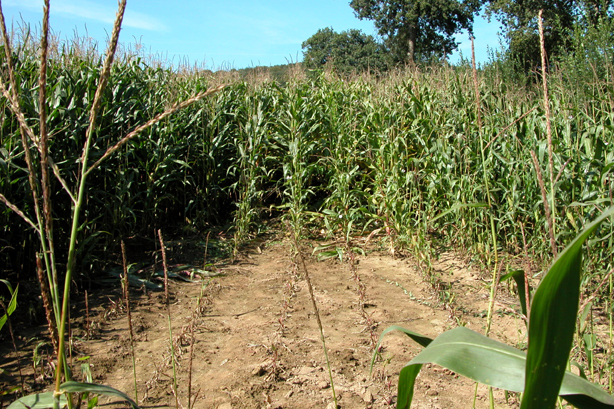
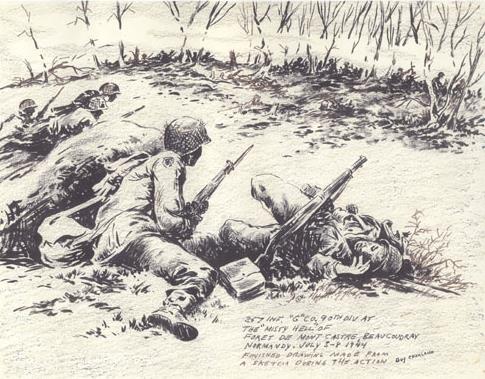
Hill 122
The battle of Monte Castre
The battle of Monte Castre